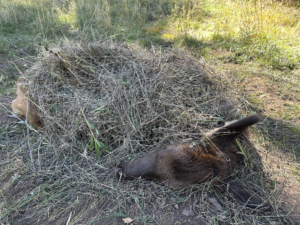Author’s Note: The following videos show a natural process that some viewers may find graphic.
Imagine pulling up your home to find a mountain lion, the elusive ghost of the forest, casually dining on an elk in your yard. Most of us would choose a couple of pink flamingos over a fresh elk carcass and an apex predator, but for Taos resident and New Mexico Wild’s Northern Conservation Director Garrett VeneKlasen, this discovery turned into an unforgettable multi-day experience. He found himself with a front-row seat into a natural process humans rarely have the opportunity to observe in real-time. “I have enormous respect for mountain lions,” wrote Garrett in the first of a series of social media posts he shared about the event. “They play a critical role in our ecosystem and no other animal in our forest matches their power, grace, and stealthy aura.”
Garrett wasted no time in documenting the extraordinary event, calling in Friends of Rio Grande del Norte Coordinator Nick Streit for backup in setting up motion cameras from a safe distance away to capture the unfolding drama. What followed over the next several days was a captivating series of events caught on video, featuring not only the majestic mountain lion but also an entire cast of other wild characters, each with its own quirks and appetite.
In the first video, we see the mountain lion’s meticulous efforts to cover the elk carcass with grass after feasting on fresh meat for several hours. As she walks towards the camera, this elegant predator displays behaviors charmingly reminiscent of a house cat, shaking the grass and blood from her paws, one foot at a time, before settling into a fastidious grooming session out of frame. Whether they are 10 pounds or 110 pounds, all cats undeniably share many of the same behaviors!
Lucky for us, the forest has more surprises in store. A massive black bear, a true giant of its kind and one of the largest bears Garrett has ever seen, soon lumbers out of the dark and into the scene, quickly scaring the mountain lion away. The black bear is New Mexico’s State Mammal and is capable of consuming staggering amounts of calories–upwards of 20,000 in a single day–in preparation for winter hibernation. This bear wastes no time in taking over the feast before resting his (giant) head next to the elk for a little snooze.
Before leaving the kill site for the night, the bear covers the elk in more grass with its paws. ”Both bears and mountain lions regularly cover their prey with a thick layer of grass and sticks after they finish a meal. This serves many purposes—it deters the birds and keeps the meat cool. This delays spoilage. Spoilage isn’t necessarily so bad from an eating standpoint, as bears especially relish eating rotten carrion, but the worse the kill smells, the more it attracts attention from a host of other scavengers, especially other bears,” explains Garrett.
During the day, the avian scavengers arrive. Garrett writes, “The number of ravens and magpies is astounding. Keep in mind that a 4-pound raven can eat up to 10% of its body weight per day. There are at least 75 ravens and magpies coming and going.”
On the second night, and only minutes after the lion last appeared on the camera, a large bobcat suddenly ventures onto the kill site. Mountain lions kill and eat bobcats, so this is a very dangerous place for the bobcat to be! The bobcat’s careful and intentional movements are a marvel, demonstrating the cautious nature of these forest phantoms. Later, a curious coyote prances through the scene.
In the midst of wonder and amazement, we can’t ignore the messy realities of nature. The videos and images Garrett and Nick captured reveal the brutal truth of the circle of life. ”Nature is harsh and graphic at its very core, but we often don’t want to acknowledge this fact,” Garrett reflects in his final post of the series. “Most of us, myself included, live in a candy-coated, gilded fantasy world and hate to be reminded of life’s harsh realities. We, too, are creatures of nature, though really nothing more than toy poodle versions of our ancestral selves.” This confrontation with graphic nature forces us to consider our own inherent vulnerabilities and imperfections, laying bare the violence that we’re capable of as a species.

“The elk was a beautiful calf born in June of this year. She was full of life, promise, and vigor, and her untimely demise was undoubtedly extremely violent and traumatic—not just for her but for her mother as well. We see ourselves as evergreen through an unrealistic arc of time, yet the unrelenting aging process and our eventual mortality reveal our vanity.” A profound truth emerges in observing this process: death, as brutal as it may seem, becomes the catalyst for life’s continuation. The elk’s demise becomes the source of sustenance, vitality, and growth for countless organisms, from apex predators like bears and mountain lions to the intricate, living web of plants and microorganisms thriving around the kill site.
Garrett’s parting words remind us that the desire for eternal youth pales in comparison to the natural order. “Death begets life and all life ends in death. It’s hard to see ourselves as a casualty in this natural cycle of life.”

